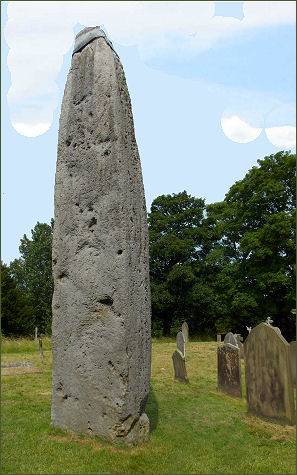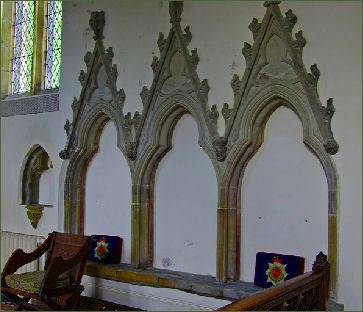The Rudston Monolith
OS grid reference:- TA 097 677
 The Rudston Monolith is the tallest standing stone in Britain, it measures over 7.6 metres (25 feet) high, nearly 2 metres wide, a metre thick, and has an estimated weight of around 40 tons. The megalith is situated in the churchyard in the village of Rudston in East Yorkshire.
The Rudston Monolith is the tallest standing stone in Britain, it measures over 7.6 metres (25 feet) high, nearly 2 metres wide, a metre thick, and has an estimated weight of around 40 tons. The megalith is situated in the churchyard in the village of Rudston in East Yorkshire.
The nearest source of Moor Grit Conglomerate stone of the type the standing stone is composed of is found at Cayton Bay about 10 miles to the north or the Cleveland Hills. The stone was erected in the late Neolithic or Bronze Age.
A smaller stone, of the same type, also stands in the churchyard, it is said to have been once situated near the large stone. There is also the remains of a double cist that was removed from a nearby barrow on Rudston Beacon by the antiquarian Canon Greenwell in the late nineteenth century.
The Norman church of All Saints was almost certainly intentionally built on a site which was already considered sacred. The name of Rudston is thought to derive from the Anglo-Saxon "Rood-stane", meaning "cross-stone", implying that a stone already venerated was adapted for Christian purposes.
In 1861 during levelling of the churchyard some 1.5 metres (4.9 ft) of the monolith was buried beneath ground. Sir William Strickland is reported to have conducted an experiment in the late eighteenth century determining that there was as much of the stone below ground as is visible above. He found many skulls during his dig and suggested they might have been sacrificial.
The fossilised dinosaur footprints on one side of the stone may have contributed to its importance to those who erected it. The flat face of the stone faces the midwinter sunrise in the south-east.
All Saints Church Rudston
 All Saints church in Rudston, a Grade I listed building, dates to the Norman era and built around the year 1100 by William Peverel, lord of the manor and said to be an illegitimate son of King William the Conqueror. Of the Norman building the tower survives, and visitors can trace the original west entrance in the stonework at the west end of the church.
All Saints church in Rudston, a Grade I listed building, dates to the Norman era and built around the year 1100 by William Peverel, lord of the manor and said to be an illegitimate son of King William the Conqueror. Of the Norman building the tower survives, and visitors can trace the original west entrance in the stonework at the west end of the church.
The Norman building was extended in the thirteenth century when both north and south aisles were added. The nave and chancel arch date from this rebuilding. In the sanctuary is a slightly later sedilia, or stone seat (pictured right). At the base of the piscina is a piece of reused masonry, possibly from a local Roman Villa, with the head of Medusa carved on it. In the north aisle is a squint, provided when the north aisle was added so that people standing there could still see the altar.
The west end of the church is partly dominated by a huge organ, which was a gift of by Sir Alexander MacDonald of the Isles.. A plaque to Sir Alexander is set on the chancel wall. At the west end of the south aisle is a monument to Winifred Holtby, author of 'South Riding'. Holtby lived and wrote at Rudston House, and her grave is situated at the west end of the churchyard.
Below Winifred Holtby's wall memorial stands a beautifully decorated tub shaped Norman font, which is carved with geometric patterns and stands on a simple stone plinth. A font-like basin under the table at the back of the south aisle is believed to be a holy water stoup dating from the thirteenth century. Also of that century, or perhaps a little earlier, is the Mediaeval Stone Coffin Cover, located at the west end of the south aisle. It bears some quite deep grooves and these are likely to have been made by medieval people using it as a sharpening stone.
Most of the Stained Glass in the Windows is modern, designed by Hardman and replacing nineteenth century glass by Capronnier of Brussels and Hodgson of York, destroyed by a land mine in the Second World War.
Prehistoric and Roman Sites of Yorkshire
